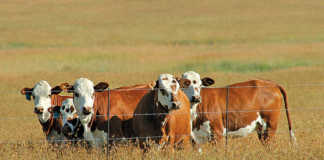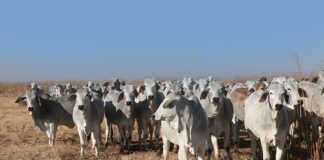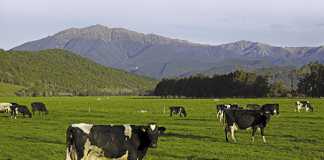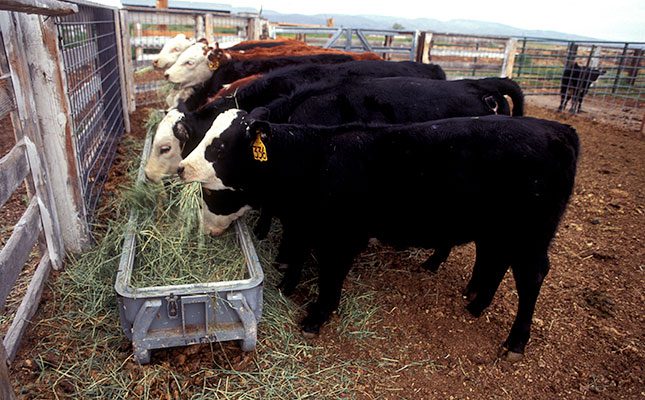
Photo: Wikimedia Commons
There are numerous feed ingredients possible for cattle diets and numerous ways to combine those feed ingredients to meet beef cattle daily requirements, according to Tara Felix, an extension beef specialist, and Nathan Briggs, a former beef extension educator, both from Pennsylvania State University in the US.
They say that formulating a diet for beef cattle and feeding a balanced ration are essential to running a profitable beef operation.
“Most beef cattle nutritionists and producers begin balancing a ration using a least-cost formulation that considers the overall cost of mixing the diet and feeding the daily ration. Proper ration formulation for animal class allows nutritionists to predict how long beef cattle will need to be fed to achieve a targeted body weight,” say Felix and Briggs.
They add that before a diet can be formulated and a ration developed for gain predictions, the following things need to be known: the animal type; sex; weight; available feed ingredients; use of feed technologies; and housing type. This article will focus on animal type, sex and housing type in particular.
“These categories are important because each one impacts the nutrients required for maintenance and gain of beef cattle. There are truly only six classes of nutrients for any animal (or human): water, carbohydrates, protein, fat, vitamins, and minerals. However, these nutrients are used by cattle for growth and development.
“For example, carbohydrates and fats are digested to provide energy to the animal. The terminology most commonly used to discuss beef cattle requirements is often based on broader classifications of these nutrients that explain their function in the animals: net energy for maintenance (NEm), net energy for gain (NEg), total digestible nutrients (TDN), neutral detergent fibre (NDF), crude protein (CP), fat, minerals, and vitamins. These terms group the six classes of nutrients more by their respective functions. For example, carbohydrates, fat and protein may all contribute to the NEm and Neg,” they write.
Felix and Briggs say that in many diets for growing cattle, CP ranges between 11% and 16%, NEm ranges between 78 and 91 Mcal per cwt (where cwt is equal to 100 pounds [45,35kg]), and NEg ranges between 50 and 61 Mcal per cwt.
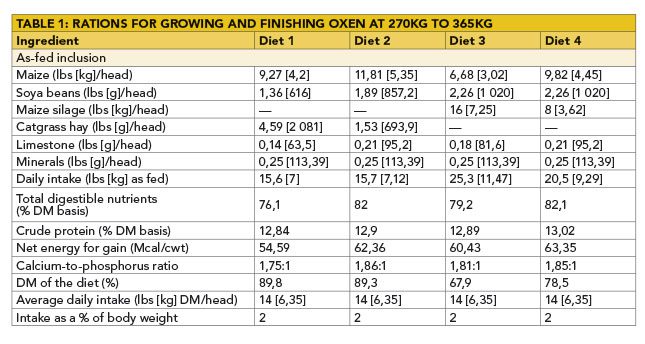
“In most grain-based diets, however, the NEg will not drop much below 54 Mcal per cwt. Feeding diets with less than 54 Mcal per cwt would be more typical in a forage-based management programme. The fat content of a beef cattle diet should not exceed 6% to 7% of the diet. And, while minerals and vitamins are often fed as a commercial premix that is added at a specified amount to the daily ration, it is important to point out that the ratio of calcium to phosphorus (Ca:P) should be 2:1 in the total diet. Repercussions of not meeting these requirements will be poor growth, impaired health, and insufficient nutrient utilisation.”
However, as Felix and Briggs say, “one might question the seemingly broad range for the rules of thumb provided”.
“Typically, diets fed to growing beef cattle will step up, or increase, in energy over the course of the feeding period. This stepwise increase allows the calf’s rumen to adjust to changes in the diet, primarily increasing concentrations of grain necessary to increase energy density. For example, a 181kg calf may start in the feedlot consuming a diet of 56 Mcal of NEg per cwt. This diet would likely contain 40% maize grain (dry matter basis) or less.
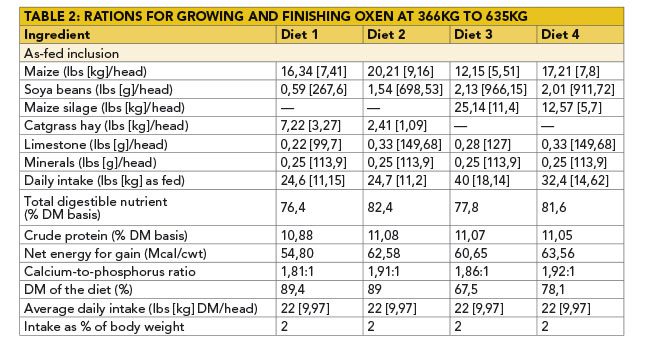
“The calf would then transition to a diet of 58 or 59 Mcal of NEg per cwt after a week to 10 days and then to a diet of 60 to 62 Mcal of NEg per cwt after another week to 10 days. This calf would then remain on, or ‘finish on’, 60 to 62 Mcal of NEg per cwt until slaughter, but its daily intake, or ration, would likely increase as time went on.
In addition, this stepwise increase allows nutritionists and producers to adjust the concentrations of protein in the diet to achieve the desired grams of protein consumption per day. Because lighter cattle cannot physically eat as much feed, the diet fed to them must have a greater concentration of protein in order to achieve a similar grams/day intake of protein. The difference between concentration and consumption is evidenced in the examples below.”
As such, ingredients and their proportion may differ to meet those varying crude protein and NEg requirements based on animal intake, they explain.
“Along these lines, we know though that the amount of fibre in the diet will affect how much of the diet that growing calf will be able to consume. Beef cattle intakes can range from 2% to 3,5% of body weight (BW) on a dry matter (DM) basis, with young calves consuming more than older cattle.
“Feeding predominantly fibre, or a forage-based diet, will limit cattle intakes closer to 2% of their BW. With less fibre in the diet, lightweight cattle (under 600 pounds [272kg]) can consume up to 3,5% or even 4% of their BW. Intake, as a percentage of BW, will decrease as cattle grow. Thus, once cattle weigh between 700 to 800 pounds (317,5kg to 362,87kg), intake will be closer to 2% of BW. The transitions become critical because sick animals (cattle with either respiratory issues or digestive upsets) will consume only 1% or less of their BW (DM basis). In the instance of sickness, energy will be reallocated toward the immune system rather than performance, and growth will be retarded.”
They add that the breed and sex of the animal will also affect its nutrient requirements. Heifers, for example, fatten more quickly than oxen.
“An Angus calf will grow differently than a Charolais on a similar ration. Dairy breeds and crosses typically require ‘hotter’ rations, or a ration with more NEg, when compared with beef breeds. Cattle type is just one of the many categories that must be considered when feeding growing cattle,” they explain.
Housing type must also be factored into feeding decisions. “Housing cattle in a manner that permits wet, matted haircoats increases nutrient requirements compared with cattle that are kept dry. In the winter, keeping animals out of the wind and dry [where applicable] can help ensure the most efficient use of nutrients.” With this in mind, Felix and Briggs have prepared sample diets for three different management scenarios with result economic analyses.
Diet 1
Felix and Briggs formulated Diet 1 to meet the requirements for starting 272kg Angus-based steers and feeding until finish weight.
“Diet 1 is an attempt to depict a free-choice hay scenario with separate grain feeding. However, free-choice hay feeding scenarios are difficult to model due to fluctuations in individual cattle intakes of both hay and grain.
Therefore, Diet 1 includes hay at 30% of total DM because research suggests that cattle given free access to hay will consume close to 30% of their daily DM as hay. Other feeds in this diet include maize unroasted or raw soya beans limestone, and a commercial vitamin/mineral premix.
Growth predictions have been made based on the assumption that no feed technologies are being used. If feed technologies such as ionophores, beta agonists or implants are used in combination with these diets, increased weight gain and profitability would be realised.
“Adequate pen and bunk spacing requirements were assumed. If cattle are overcrowded or do not have enough space, increased competition at the bunk can reduce intake while increasing the risk of illness in the pen.”
Diet 2
Diet 2 was formulated to meet the requirements for starting 272kg Angus-based steers and feeding until finish weight. “Like Diet 1, this diet utilises hay, maize , unroasted soya beans, limestone, and a commercial vitamin/mineral premix. However, unlike the first diet, this diet limits hay intake to 10% of the DM inclusion in an effort to increase average daily gain and feed efficiency. Growth predictions have been made based on the assumption that no feed technologies are being used. Adequate pen and bunk spacing requirements were assumed.”
Diet 3
Diet 3 was formulated to meet the requirements for starting 272kg Angus-based steers and feeding until finish weight. “This diet assumes feeding maize silage at 40% (DM basis) of the diet along with maize, unroasted soya beans, limestone, and a commercial vitamin and mineral mix. Growth predictions have been made based on the assumption that no feed technologies are being used. Adequate pen and bunk spacing requirements were assumed.”
Diet 4
“Similar to the previous scenarios, Diet 4 has been formulated to meet the requirements for starting 272kg Angus-based steers and feeding until finish weight. This diet also utilises home-raised maize silage, like Diet 3. However, in Diet 4, maize silage is included at only 20% of the diet (DM basis) to demonstrate the growth performance and economic differences realised when fed ‘hotter’ diets. Growth predictions have been made based on the assumption that no feed technologies are being used. Adequate pen and bunk spacing requirements were assumed.”
Source: extension.psu.edu/ration-formulation-for-growing-cattle.








